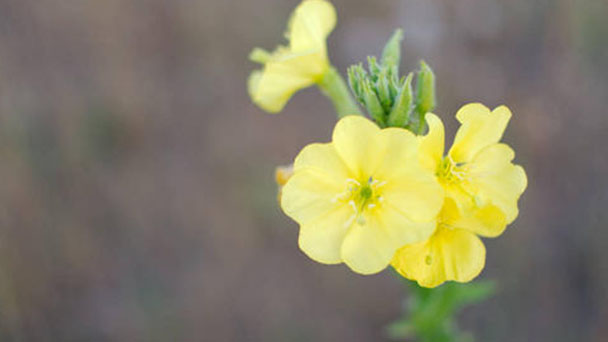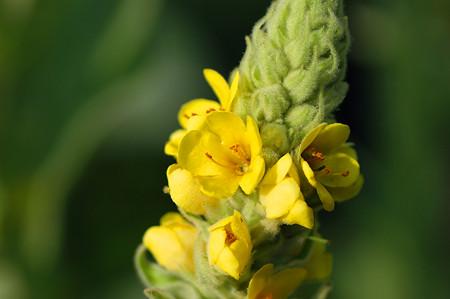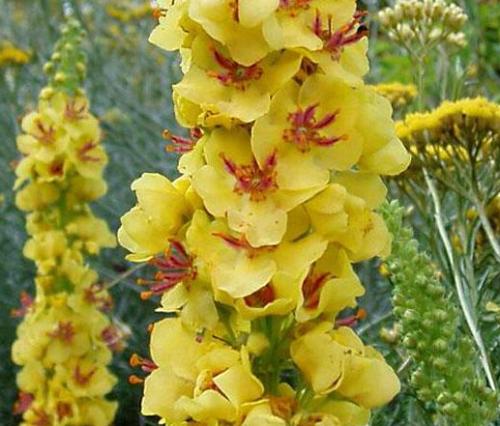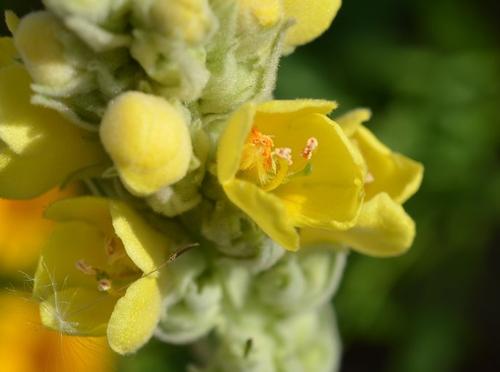Verbascum thapsus (common mullein) profile
Written by Maggie
Feb 26 2021

Common Mullein, scientific name Verbascum thapsus, belongs to the genus Common Mullein of Sphalophoraceae. Common Mullein is a biennial herb, stems erect, 1-1.7 m tall. The whole plant is densely yellow tomentose with stellate hairs. Basal leaves are oblong-oblong, 10-25 cm long, 5-8 cm wide; Cauline leaves gradually shrink to be oblong, the base extends down into narrow wings. Spicate of Common Mullein is terminal, corolla yellow, flower diameter 1-2 cm. Capsule is ovoid, seed majority, fine, rough. The whole grass contains volatile oil, aromatic plants.
Common Mullein picture

Morphological characteristics of common mullein
Strain
Common mullein is a biennial herb, up to 1.5 m tall, covered with dense, grayish yellow stellate hairs.
Leaf
The basal leaves and lower stem leaves of common mullein are oblanceolate and oblong, tapering to a short stalk at the base, up to 15 cm long and 6 cm wide, margin shallowly crenate, the upper stem leaves gradually shrink to oblanceolate to ovate-oblanceolate, and the base extends downward into narrow wings.
Flowers
Common mullein is a spike terete, up to 30 cm long and up to 2 cm in diameter, elongate and thickened as a result, flowers dense, several clustered (at least proximally), pedicels very short; Calyx ca. is 7 mm, lobes lanceolate; Corolla of Common Mullein is yellow, 1 -- 2 cm in diameter; Common Mullein has 5 stamens, filaments 3 posteriorly hairy, filaments 2 anteriorly glabrous, anther base more or less descending into a glyph.
Fruit
Capsules of common mullein ovate, about as long as persistent calyx.
The ecological habits of common mullein
Common mullein is robust, hardy, and prefers well-drained limestone soils to hot, rainy climates and cold, wet, sticky and heavy soils.
Common Mullein grows hillside grassland and riparian grassland, 1400-3200 meters above sea level.
Propagation of common mullein
Generally, direct seeding is adopted, and seedlings of Common Mullein can also be transplanted. In the whole ground, open 1m wide bed, according to the plant spacing of 50cm, hole two rows, about 7cm deep, add human and animal dung water, and then every 1hm2 with 900-1350g of seeds, mixed into the plant ash mixed with human and animal dung water, evenly scattered in the field.

Common Mullein growing methods
When the seedlings have 3-4 true leaves, the seedlings should be uniform and replenished, and 1 seedling should be left in each space. At the same time, intertillage, weeding and topdressing should be done once for winter. The second year in spring, and then leave seedlings weeding, topdressing 1 times. Fertilizer to human and animal dung water, but to master the first light after thick, and pay attention not to apply on the leaves.
Disease control of common mullein
Common Mullein's diseases include root rot, which can be controlled by lime-water sprinkling holes.
Common Mullein's breed taxonomy
Cultivated varieties: Southern charm, beautiful.
Common Mullein's distribution area
Common mullein is native to Xinjiang, China. It is also found in southern Europe, Russia and Siberia.
Common Mullein is distributed in Xinjiang, Jiangsu, Zhejiang, Sichuan, Yunnan and Tibet.
Common Mullein main value
Dietary or medicinal value of common mullein
Common Mullein can clear heat and detoxify, stop bleeding and dissipate stasis. Common Mullein can treat pneumonia, chronic appendicitis.Sores, bruises, sprains, wounds and bleeding.
Garden use in Common Mullein
The purple common mullein, with its dense clusters of large erect inflorescences, is spectacular. Common Mullein is suitable for flower border material, also can be planted in the forest margin gap. Common Mullein can be potted flowers, flower beds and large container cultivation, landscape and garden planting.

Latest Updated
- Benefits of Bugleweed - 7 Science-backed Health Benefits
- Bugleweed Dangers & Side Effects - Is It Poisonous?
- How to Plant Evergreen Trees - What You Should Know
- When to Plant Evergreens - Grow Guide for Evergreen Trees
- 12 Wonderful Evergreen Shrubs for Your Garden
- 12 Popular Evergreen Plants with Pictures for Beginners
- When And How To Prune A Lilac Bush Like a Pro
- How to Grow & Care for Lilac Vine (Hardenbergia Violacea)
- Japanese Lilac Tree (Syringa Reticulata) Care & Propagation Guide
- Shumard Oak Pros and Cons - What to Know
Popular Articles
- Winter maintenance of Antirrhinum Majus
- How to Grow Terminalia Mantaly Tree
- How to Grow and Care for Crossostephium Chinense
- How to grow Antirrhinum Majus in spring
- Peristeria Elata (Dove Orchid) Profile: Info & Care Guide
- Underwatered Snake Plant (Sansevieria Trifasciata) - Signs And How To Fix
- How to Care for Brazilian Jasmine Plant (Mandevilla Sanderi)
- How to Grow & Care for Graptopetalum Purple Delight in Summer
- Rosa Chinensis (China Rose): Plant Growing & Care Tips
- How to Care for Baby Sun Rose (Aptenia Cordifolia)